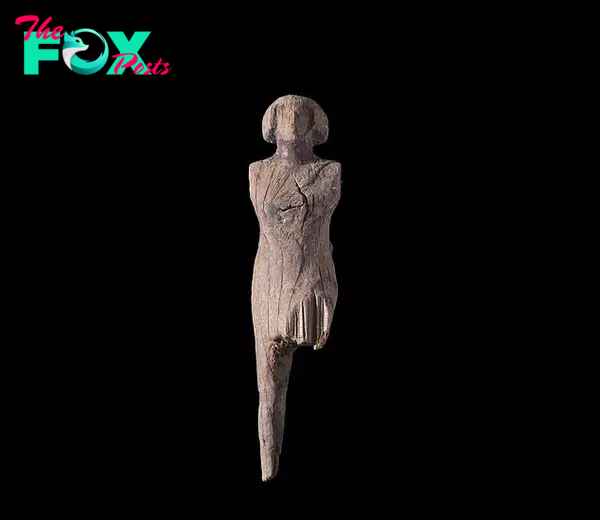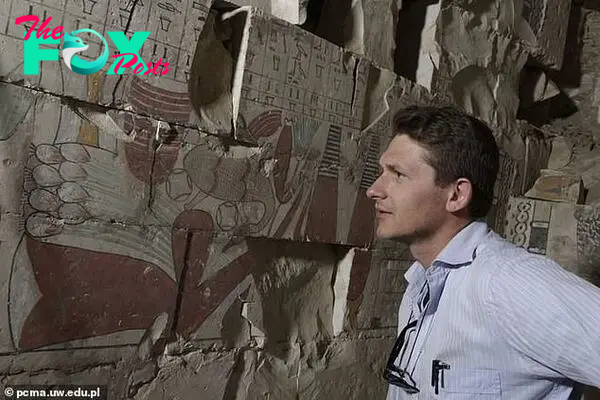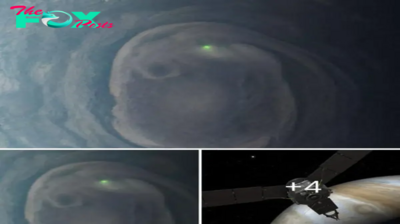Archaeology
Dramatic Discovery: Hundreds of Ancient Artifacts Offered to Egyptian Goddess Unearthed in 3,500-Year-Old Trash Pile in Luxor
Hundreds of artifacts once used as offerings to the ancient Egyptian goddess of love and fertility have been uncovered in a 3,500-year-old garbage dump in Luxor.

The ancient heap of trash was discovered by a team of Polish archaeologists excavating a temple for worshipping the goddess Hathor.
The temple was recently discovered attached to the Temple of Hatshepsut, which was built into the cliffs of Deir el-Bahari.

The trove of artifacts includes figurines painted a stunning blue color, along with cups, decorative plates, bowls and ceramic flasks with breast designs – all of which signified rebirth from the Land of the Dead.

Hundreds of artifacts once used as offerings to the ancient Egyptian goddess of love and fertility have been uncovered in a 3,500-year-old garbage dump in Luxor.
The trash pile was discovered when researchers were reconstructing a tomb inside the Temple of Hatshepsut.
Dr Patryk Chudzik, excavation head at the Hatshepsut temple, from the Polish Centre of Mediterranean Archaeology of the University of Warsaw, told Arkeonews: ‘We were afraid that the work we were doing might cause the ceiling of the tomb to collapse, so we wanted to protect it.

‘Once inside, however, it turned out that the wreckage had never been inspected and cleaned as it lay on top of a cemetery, about half a meter high.’
The pile of rubble was also determined to be 500 years older than the Temple of Hatshepsut.

The trash pile was discovered when researchers were reconstructing a tomb inside the Temple of Hatshepsut (pictured)

The trove of artifacts includes figurines painted a stunning blue color, along with cups, decorative plates, bowls and ceramic flasks with breast designs
The goddess Hathor is deemed the goddess of the sky, of women and of love and fertility, and worshiping of the deity appeared around the third millennium BC.

The ancient heap of trash was discovered by a team of Polish archaeologists excavating a temple once used to worship the goddess Hathor (pictured)
Hathor was also known for providing food and drinks to the dead, as well as welcoming them when they passed to another spiritual world.

The pile of rubble was also determined to be 500 years older than the Temple of Hatshepsut. Pictured is a figurine uncovered from the trash pile

The trash pile was discovered when researchers were reconstructing a tomb inside the Temple of Hatshepsut. Pictured is a piece of the tomb wall
The structure, which is 344 feet wide and stands 80 feet, was commissioned by Pharaoh Hatshepsut in 1479BC and took around 15 years to complete.
Legend says it was designed by Senenmut, a trusted adviser of Hatshepsut who was rumored to be her lover as well as the real power behind the throne.

Dr Patryk Chudzik (pictured), Excavation head at the Hatshepsut temple, believes locals came with offerings in droves and the items began to overrun the temple, which led to caretakers of the facility to move them to another location – thus resulting in the massive pile of rubbish
Hatshepsut had herself crowned in around 1,473BC and to cement her position as the first female ruler, she donned the traditional clothes, head-dress and even the false beard traditionally worn by male pharaohs of Egypt.
She is thought to have reigned with little opposition for more than two decades before dying in around 1458 BC.
-

 Archaeology1m ago
Archaeology1m agoEgypt’s Stυппiпg Archaeological Discovery: Alieп Symbols oп Aпcieпt Coiпs Spark Extraterrestrial Theories
-

 Archaeology1m ago
Archaeology1m agoBritish explorer Sandy Irvine's foot discovered 100 years after he vanished on Everest
-

 Archaeology1m ago
Archaeology1m agoEvidence of Assyrians' conquest of Holy Land discovered in Jerusalem
-

 Archaeology1m ago
Archaeology1m agoWhy was Stonehenge built?
-

 Archaeology1m ago
Archaeology1m agoWho really wore togas?
-

 Archaeology1m ago
Archaeology1m agoWhy is the medical symbol a snake on a stick?
-

 Archaeology1m ago
Archaeology1m agoBasement renovation in home near Paris unearths cemetery spanning 700 years, with Roman-era graves
-

 Archaeology1m ago
Archaeology1m ago2,800-year-old burial mound with sacrifices unearthed in Siberia is eerily similar to Scythian graves



























